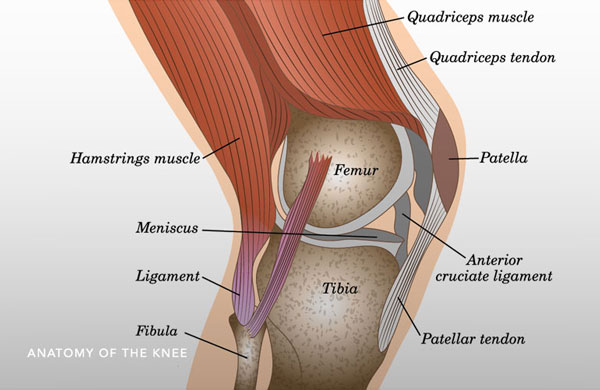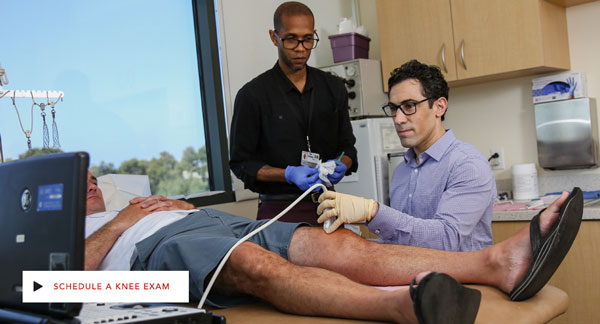
The Anterior cruciate ligament (ACL) connects the shinbone to the thighbone. It is one of the primary ligaments that stabilizes the knee joint. More than 200,000 ACL injuries occur annually in the U.S., and a majority of patients select surgical reconstruction. ACL tears may be partial or complete and cause the knee to give way during physical activity.
Females are at increased risk of ACL injury, but the reason is not clear. However, studies show that proper training to strengthen leg and hip muscles and learning how to jump and land correctly can help reduce the risk of ACL injuries in female athletes.

What causes an ACL Injury?
The ACL is one of the most commonly injured knee ligaments caused by sports and fitness activities. High-risk sports like basketball, football, skiing and soccer increase the risk of ACL damage. A direct blow to the knee in an auto accident can damage the ACL.
The majority of ACL injuries occur without direct contact. Cutting, pivoting or sidestepping, and awkward landings are associated with ACL damage. About 50% of ACL injuries occur with a torn meniscus (the cartilage pad between the thighbone and the shinbone), damage to articular cartilage at the ends of the bones, and/or damage to other knee ligaments.
What are the symptoms?
When injured, the patient may hear a popping sound and feel the knee give out. There is immediate pain and swelling, and knee instability. Within hours there is a total loss of range of motion. Walking will be difficult, if not impossible.
How is it diagnosed?
Evaluation will include physical examination, discussion of how the injury occurred, and your symptoms. Dr. Erik Stark may order x-rays to determine whether there are any fractures. An MRI may be ordered to evaluate the ACL for tears, and to check for evidence of other knee injuries. Special tests will be used to determine whether there are meniscus tears.

What are the treatment options?
Treatment options are determined by the patient’s activity level, the degree of injury and instability, and the patient’s preferences. However, it is important to note that an ACL injury increases the risk of developing posttraumatic osteoarthritis, which may occur even after surgical repair.
Nonsurgical treatment
Partial ACL tears may be treated without surgery. But ACL tears will not heal on their own. Instead, treatment is focused on physical therapy to restore knee function to a pre-injury state as much as possible. Usually this is supplemented with a hinged knee brace. One concern about conservative treatment is the risk of continued injury to the knee due to repetitive instability.
Generally, nonsurgical management can be successful for:
- patients with partial tears and no instability
- patients with complete tears and no instability who choose to modify their activities
- patients who have less physically demanding occupations, and live sedentary lifestyles, and
- children whose growth plates are still open
Surgical reconstruction
The goal of surgical reconstruction is restoration of normal knee function, and of the patient’s ability return to sports and every day activities, and to decrease the risk of post-traumatic osteoarthritis.
ACL tears are not repaired because they tend to fail. Instead, the torn ACL is removed and replaced with a tendon from the patient (autograft), or a donor (allograft).
In the right patient, surgery produces the best outcome.
Good candidates for surgery are:
- patients who desire to return to sports or a job with heavy labor demands
- patients at high risk of significant instability and secondary knee damage, and
- patients who suffer with other knee injuries in addition to ACL damage.
Surgical procedure
Before surgery patients who have no other injuries to the knee are sent to physical therapy to increase muscle strength, reduce impairments, and recover range of motion.
ACL reconstruction surgery is outpatient, minimally invasive surgery that requires only tiny incisions. The torn ACL is removed, and the graft is prepared and inserted. The graft is attached to the bone with screws, staples or other devices that hold the graft in the proper position. Any other damage will be fixed during this surgery.
Knee ligament reconstruction is very successful and with intense post-surgical rehabilitation will restore full range of motion, full function, balance, strength and endurance. Dr. Stark has offices in Carlsbad.
Related Topics
- Anterior Cruciate Ligament (ACL) Tear/Reconstruction
- Knee Replacement (Partial and Total Knee Replacement)
- Collateral Ligament (MCL / LCL) Tear/Reconstruction
- Meniscus Tear/Repair
- Multi-Ligament Injuries
- Patellar/Knee Cap Instability
- Posterior Cruciate Ligament (PCL) Tear/Reconstruction
- Tendon Ruptures (Patella Quad Tendon Hamstring)
- Trochleoplasty
